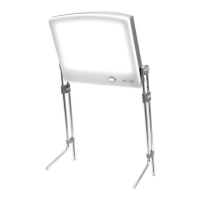Day-Light User Guide
Disclaimer
The Day-Light is an innovative light supply system – not a medical device. We recommend that you
consult a physician before undertaking a bright light therapy regime, especially if you suffer from a
mood disorder such as depression, are on prescription medications, have a history of eye conditions, or
are under a physician’s care for any reason.
Safety Precautions
1. As with any electrical device, do not use the
Day-Light in or near water.
2. Do not overuse the Day-Light. Recommended
usage is 20-30 minutes each morning. Overuse may
cause irritability, excessive energy, or difficulty
falling asleep at bedtime.
3. It is not necessary to stare into the light. Feel free
to read, work, eat or talk on the phone during your
light therapy session. See page 7 for correct
positioning.
4. During the first few uses, your Day-Light may give
off an odor; this is harmless. This will not affect
the use of your Day-Light and will quickly
disappear.
By Uplift Technologies Inc.
CAUTION
Light energy can interact with and damage skin and eye tissues, especially when a photosensitizing mole-
cule – whether from a drug or produced by the body – is bound within those tissues. The highest risk is
with invisible ultraviolet (UV) light, which has been filtered out of the Day-Light system. In addition, there
are certain pre-existing medical conditions of eyes and skin (e.g., retinal dystrophies, age-related macular
degeneration, porphyria, lupus erythematodes, chronic actinic dermatitis and solar urticaria) that can show
photosensitized reactions to intense visible light. In such cases, bright light therapy should be adminis-
tered only under guidance of an ophthalmologist or dermatologist, as indicated. Ophthalmologists should
keep in mind that in some genetic retinal diseases the eyes are especially light-sensitive. Certain medica-
tions also are known to photosensitize skin and/or retinal tissues. Examples in the visible range of light
include neuroleptic drugs (e.g., phenothiazine), psoralen drugs, antiarrhythmic drugs (e.g., amiodarone),
antimalarial and antirheumatic drugs, porphyrin drugs used in photodynamic treatment of skin diseases,
and St. John’s Wort (hypericum). Bright light therapy should not be used concurrently with these
drugs. Melatonin can be used in conjunction with light therapy at opposite times of day (e.g., evening and
morning), but if used concurrently, it can cause photosensitization. Drugs that photosensitize primarily in
the UVA range (just below 400 nm) may also have a “tail” of light absorption that extends into the lower
visible range (just above 400 nm), which could cause photosensitization. Examples are tetracycline, diu-
retic drugs (e.g., hydrochlorothiazide), sulfonamide drugs and tricyclic antidepressants (e.g., imipramine,
nortriptyline, desipramine, amitriptyline). If such a reaction is experienced or suspected, bright light ther-
apy should be discontinued unless substitute medication is available, or administered with protective
measures under medical supervision. [Sources: Vincent DeLeo, M.D., St. Luke’s-Roosevelt Medical Center,
New York; Charlotte Remé, M.D., University of Zurich, Switzerland.]

